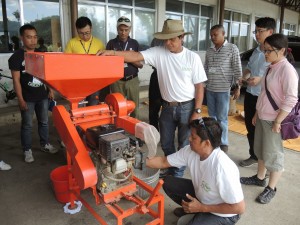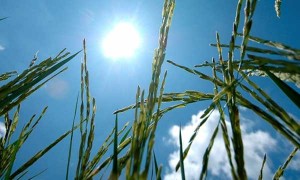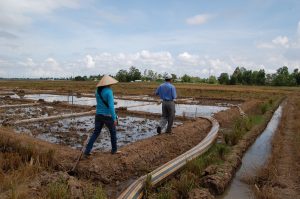The IRRI South Asia Regional Centre organized a training and hands-on demonstration to acquaint participants with alternate wetting and drying (AWD) technology for irrigation water management at Chaudhary Charan Singh Haryana Agriculture University (CCSHAU).
AWD is one of the effective technologies for conserving water resources, and reducing GHG emissions without yield penalty, according to CCSHAU Research Director Jeet Ram Sharma. Dr. Sharma requested IRRI to develop new rice varieties that perform more efficiently with direct seeding and AWD technologies. Using these efficient new varieties, the technologies can be popularized among farmers at a faster rate, he said.
Around 30 master trainers from Jind and Fatehabad Districts in Haryana participated in the program under the Credit Offsetting Rice Emissions Project funded by Deutsche Gesellschaft für Internationale Zusammenarbeit.
Read the story @IRRI
Farmers’ participatory evaluation of alternate wetting and drying irrigation method on greenhouse gas emission, water productivity, and paddy yield in Bangladesh
Due to Bangladesh’s frequent water shortages, sufficient water to irrigate rice fields is increasingly scarce. Additionally, due to global warming, severe changes in the pattern of precipitation and drought have become more prevalent, posing a substantial danger to managing water for rice farming. The purpose of this study was to determine the prospect for alternate wetting and drying to reduce greenhouse gas emissions and its effect on rice production and irrigation water saving in the farmers’ rice fields.
Determinants in the adoption of alternate wetting and drying technique for rice production in a gravity surface irrigation system in the Philippines
In Asia, AWD technology is a well-known low-cost water-saving technique for irrigated rice. Despite the potential benefits and significant efforts of creating awareness, AWD scaling and adoption remain low in the Philippines. One of the key challenges in the public-managed and large-scale-gravity irrigation system is economic incentives. The decision on AWD adoption was assumed to be influenced by a combination of socioeconomic factors, institutional arrangements within the irrigators’ association, and biophysical conditions relative to the distance to the water source.
Mitigating greenhouse gas emissions from irrigated rice cultivation through improved fertilizer and water management
Annually, Bangladesh consumes about 2.9 million metric tons of urea and about 60% of this is used in rice cultivation. Therefore, this could contribute to increasing atmospheric pollution due to increased CH4 and N2O emissions. Increasing nitrogen-use efficiency by adopting urea deep placement (UDP) could reduce environmental pollution including mitigation of GHG emissions compared to conventional nitrogen management through broadcasting method or the adoption of integrated plant nutrient system. Moreover, UDP could be more effective in mitigating greenhouse gas emissions when it is combined with alternate wetting and drying irrigation.








